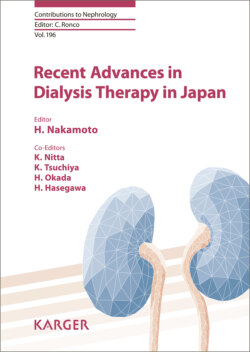Читать книгу Recent Advances in Dialysis Therapy in Japan - Группа авторов - Страница 20
На сайте Литреса книга снята с продажи.
Abstract
ОглавлениеBackground: Recent lines of evidence suggest that, as in other countries, sudden cardiac death (SCD) is more common in the Japanese dialysis clinical setting than we previously thought. Summary: Three specific important findings may underlie the increased incidence of SCD in dialysis patients. Even after successful coronary revascularization, hemodialysis (HD) patients continue to have a higher incidence of SCD than the general population. Second, about 70% or more of end-stage kidney disease patients have concentric and eccentric left ventricular hypertrophy, which predisposes many dialysis patients to interstitial fibrosis, decreased coronary perfusion reserve, and decreased ischemia tolerance. Third, mildly impaired left ventricular dysfunction, with an ejection fraction <50%, is associated with a greater risk of SCD in dialysis patients. We have believed and accepted a common sense theory that paroxysmal ventricular tachycardia and fibrillation are the central cause of SCD in HD patients, because such cardiac functional morphological abnormalities were observed, and there are many chances for ventricular arrhythmia triggers, such as volume expansion and electrolyte shift, to develop. However, the type of fatal arrhythmia responsible for SCD differs between before and after HD. Sudden cardiac arrest (SCA) from ventricular fibrillation (VF) was more often seen in the post-HD setting, while SCA from non-VF, which may be bradyarrhythmia, was more often seen in the pre-HD setting. This may imply that the causes of SCA are bradyarrhythmia due to hyperkalemia in the pre-HD setting on the day after a long interval, and fatal ventricular arrhythmia due to a prolonged QT interval in the post-HD setting, because some recent evidence suggests that shifts of electrolytes, such as potassium and calcium, during HD cause rapid prolongation of the QT interval after HD, which may lead to the onset of ventricular arrhythmia and SCD. In fact, a higher calcium gradient, defined as the difference between the pre-HD corrected total serum calcium level and the dialysate calcium level, was associated with a higher risk of SCD in HD patients. Key Messages: Further study is needed to determine which combination of calcium, potassium, and bicarbonate concentrations in dialysate is optimal to avoid SCD in high-risk HD patients.
© 2018 S. Karger AG, Basel
Cardiovascular diseases are still the leading cause of death in end-stage kidney disease (ESKD) patients, even though there have been many improvements in the practice of cardiovascular medicine, especially for coronary artery disease, over the last two decades [1]. One of the causes for this high cardiac mortality may be the potentially high incidence of sudden cardiac arrest (SCA) and/or sudden cardiac death (SCD). When one examines the status of cardiac death from registry data all over the world, there is a large difference in the cause of cardiac death in dialysis patients between Japan and other countries. In Japan, 26% of deaths are due to heart failure and only 2.5% of deaths are sudden deaths [2], while in the United States, 28% of deaths are due to arrhythmia/cardiac arrest and only 4% of deaths are caused heart failure [3]. Thus, the major cause of cardiac death in Japan is heart failure, while it is SCD in other countries. This difference provides the opportunity to explore several aspects of sudden death in hemodialysis (HD) patients and to ask whether differences in practice patterns among countries could be responsible for this difference. However, some recent lines of evidence [4–9] have shown a higher incidence of SCD in Japanese HD patients, which instigates Japanese physicians to think about SCD as a main cause of cardiac death. To reconsider the future direction of SCD, this short review focuses on current perspectives on SCD in HD patients.
